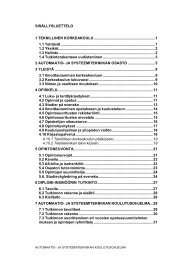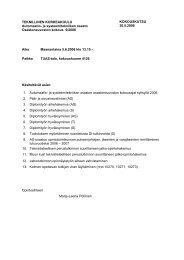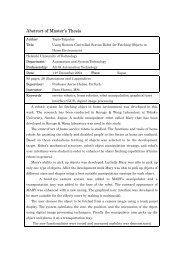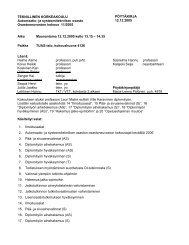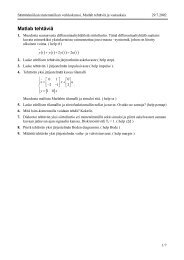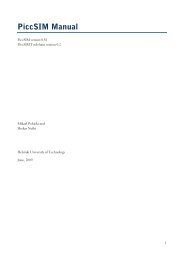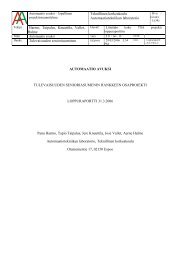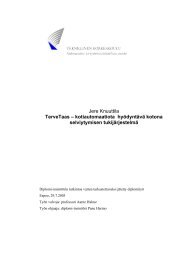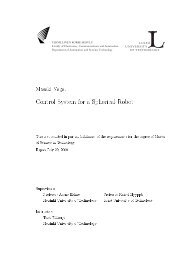FEM <strong>modelling</strong> <strong>of</strong> a <strong>bellows</strong> <strong>and</strong> a <strong>bellows</strong>-<strong>based</strong> <strong>micromanipulator</strong>II. Bellows' dimensionsThe first conclusion is that, corresponding to figures, following balance exits:A B= + t + r2+ m + r1+ t(2.1)2 2Actually, because <strong>of</strong> the measurement imprecisions, the expected result is not observed:3.175 ≠ 3.1173. This means an error <strong>of</strong> 1,85%. But it is to be noted that the thickness <strong>of</strong> thewall is not guaranteed by the manufacturer, it is only an average! It signifies that the samplecan have a different thickness. The cutting-manipulations may also have been the origin <strong>of</strong>some deformations.However, the simulations showed that the result is not substantially affected by those radii.One pressure was applied inside the <strong>bellows</strong>, with different radii, <strong>and</strong> had a look on the y-displacement. The results didn’t change more than about 0,2% when changing the radius r 1<strong>and</strong> r 2 by around 20%.It can be deduced that the assumption that r 1 = r 2 holds. For both <strong>of</strong> them, the followingvalue is used:D − 2tr1= r2= r = = 0,1778 [mm] (2.3)4Identical conclusion for m implies the subsequent equation to be used:A BA Bm = − − t − r2 − r1− t = − − 2t− 2r= 0,8382 [mm] (2.4)2 22 2The result differs only by 4% <strong>of</strong> the one measured.11
III. ModellingFEM <strong>modelling</strong> <strong>of</strong> a <strong>bellows</strong> <strong>and</strong> a <strong>bellows</strong>-<strong>based</strong> <strong>micromanipulator</strong>3. MODELLING3.1 Procedure3.1.1 WAY TO ANALYSE ONE BELLOWSThe first step <strong>of</strong> this analysis is to check if the results as given by the manufacturer areobtained by simulation. It will be later on to confirm that the radial displacement <strong>of</strong> the<strong>bellows</strong>’ wall is insignificant in comparison with the axial one when applying differentpressures into the <strong>bellows</strong>. After that, the spring ratio obtained by simulation is comparedwith that given by the designer. This phase will certify that the model behaves in a correctway.The second phase will be the most important one. It is desired to obtain the bendingbehaviour <strong>of</strong> the <strong>bellows</strong>, when applying different forces on top at different pressures. Twodifferent graphs are determined. One is the function <strong>of</strong> bending displacement versus appliedforce, under one constant pressure. The other is a check how the <strong>bellows</strong>' stiffness increaseswhen applying various internal pressures, with a constant bending-force.The third phase is the axial displacement <strong>of</strong> the <strong>bellows</strong> when applying various pressures. Inthis way, the exact relationship between pressure applied by the piezoactuator <strong>and</strong> axialmovement<strong>of</strong> the <strong>bellows</strong> is obtained.To perform these simulations, a simplified solid model is used. Indeed, the whole <strong>bellows</strong>needs not to be used, since it can be recovered using smaller parts placed in series or inparallel, depending on the analysis. The subsystem will consist <strong>of</strong> a single ring – also calledconvolution – <strong>of</strong> the <strong>bellows</strong>, as showed in figure 8. The boundary condition on its bottom hasYwhole<strong>bellows</strong> single ring Figure 8The whole <strong>bellows</strong> can be modelled bysimulating the behaviour <strong>of</strong> one single ring, <strong>and</strong>extend the results to the <strong>bellows</strong> afterwards.to be set, so that it can’t move in y-direction. The upper surface can move without anyconstraint. Then, the spring-like behaviour <strong>of</strong> the total <strong>bellows</strong> can be calculated from that <strong>of</strong>the single-ring.In order to spare CPU-time, the ring behaviour is also modelled in only two dimensions,each time while axisymmetric loads – such as the pressure – <strong>and</strong> boundary conditions areapplied. It can effectively run up to hundred times faster than the three dimensional problem.But to check if the 2-D model is accurate enough, it is first compared with the 3D one, <strong>and</strong>only afterwards the real simulations are run.3.1.2 CHOOSING RIGHT 2-D ELEMENTSA solid <strong>of</strong> revolution is generated by revolving a plane figure about an axis in the plane.Loads <strong>and</strong> supports may or may not have axial symmetry. Initially, the case where geometry,elastic properties, loads <strong>and</strong> supports are all axisymmetric will be considered. Consequently,nothing varies with the circumferential coordinate θ, material points displace only radially<strong>and</strong> axially, <strong>and</strong> shear stresses τ rθ <strong>and</strong> τ rθ are both zero. Thus the analysis problem ismathematically two-dimensional. Axisymmetric finite elements are <strong>of</strong>ten pictured as planetriangles or quadrilaterals. These plane shapes are actually referred as cross sections <strong>of</strong>annular elements, <strong>and</strong> what appears to be nodal points are actually circles (figure 9).12



